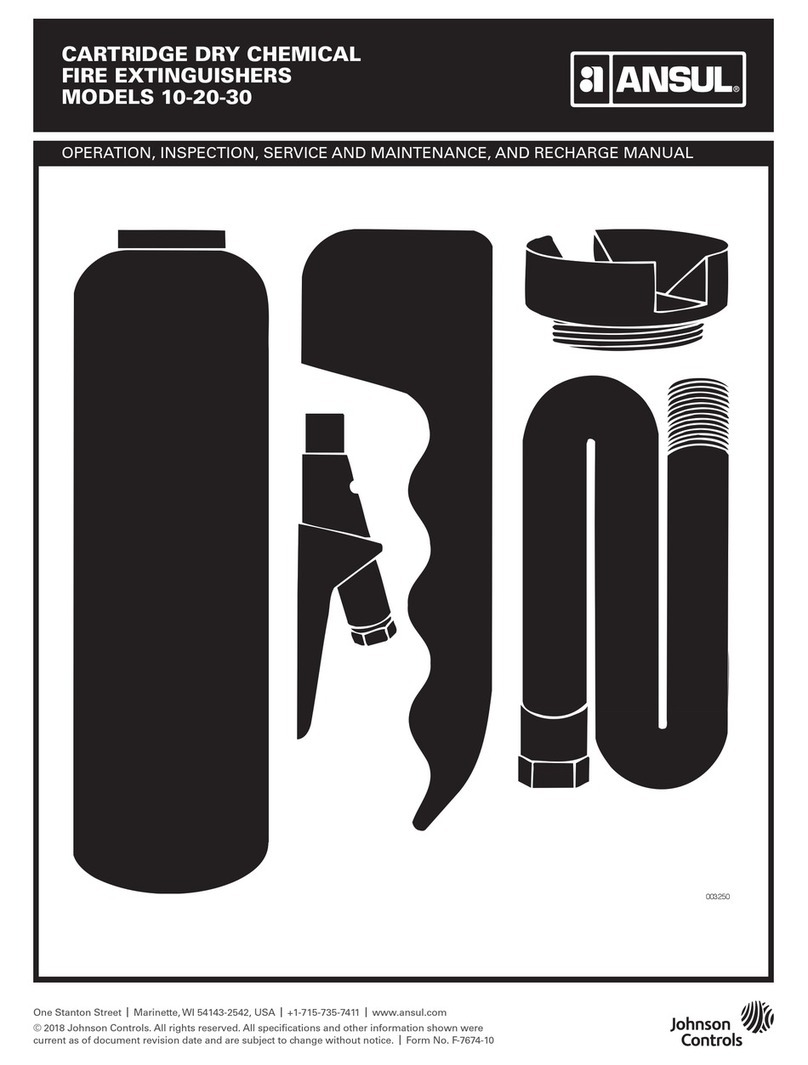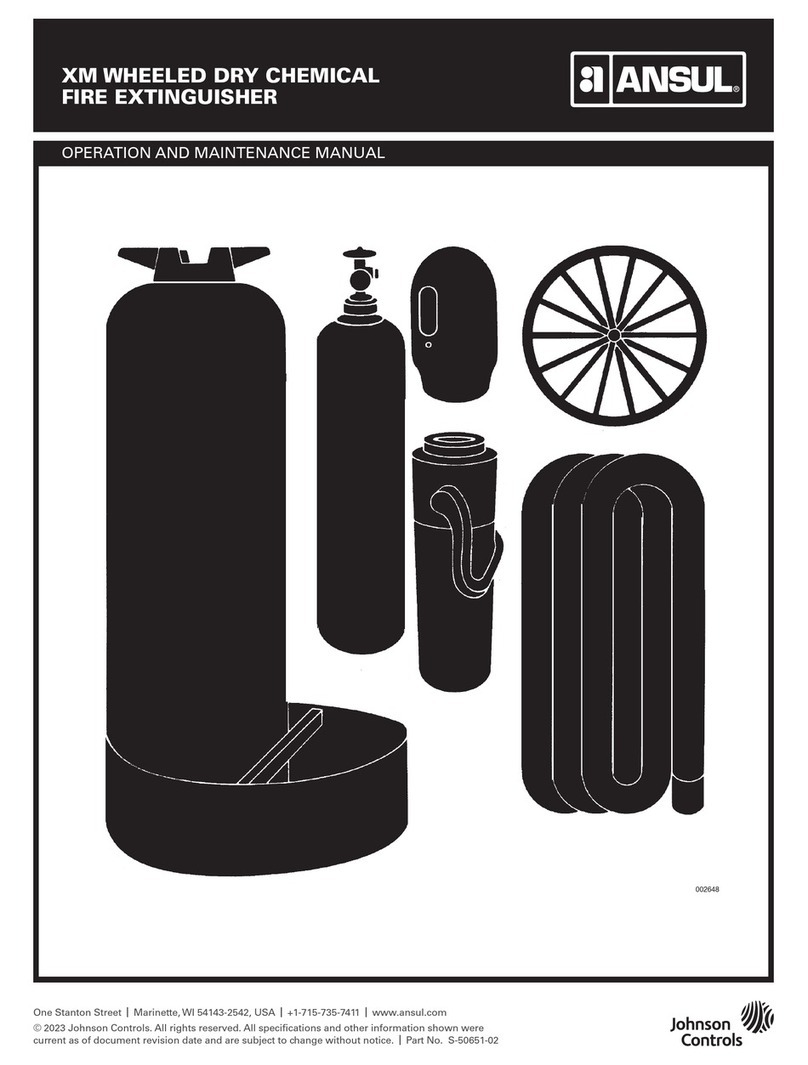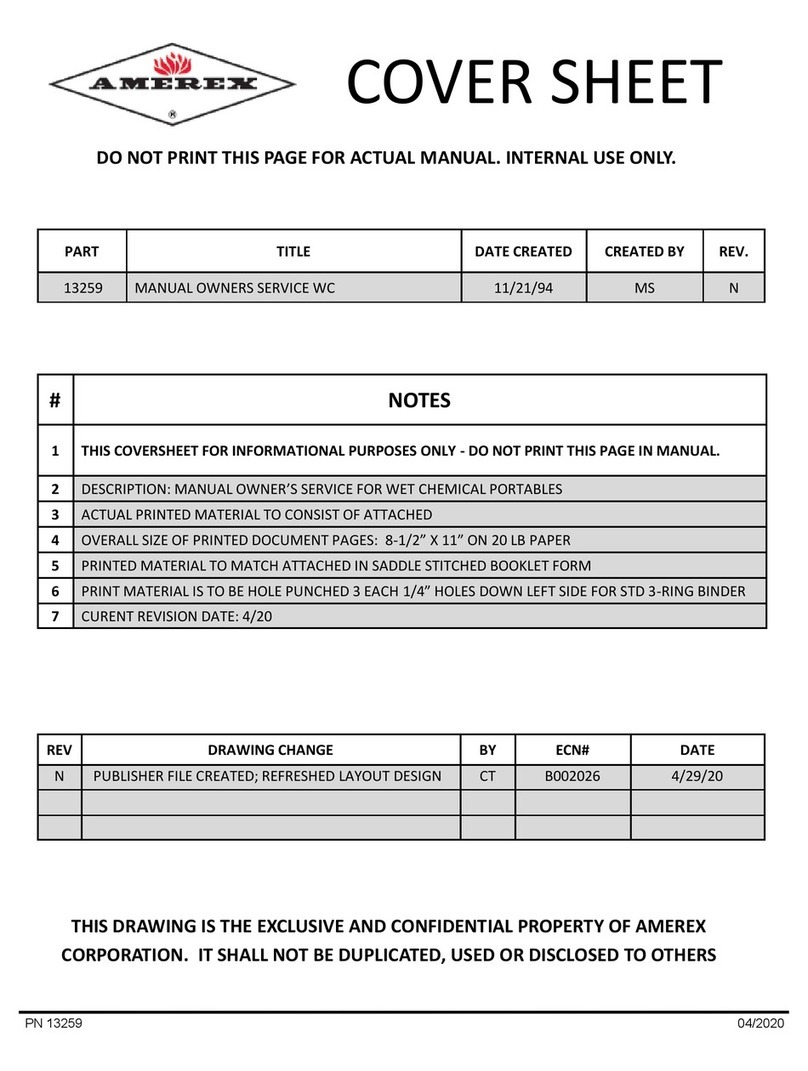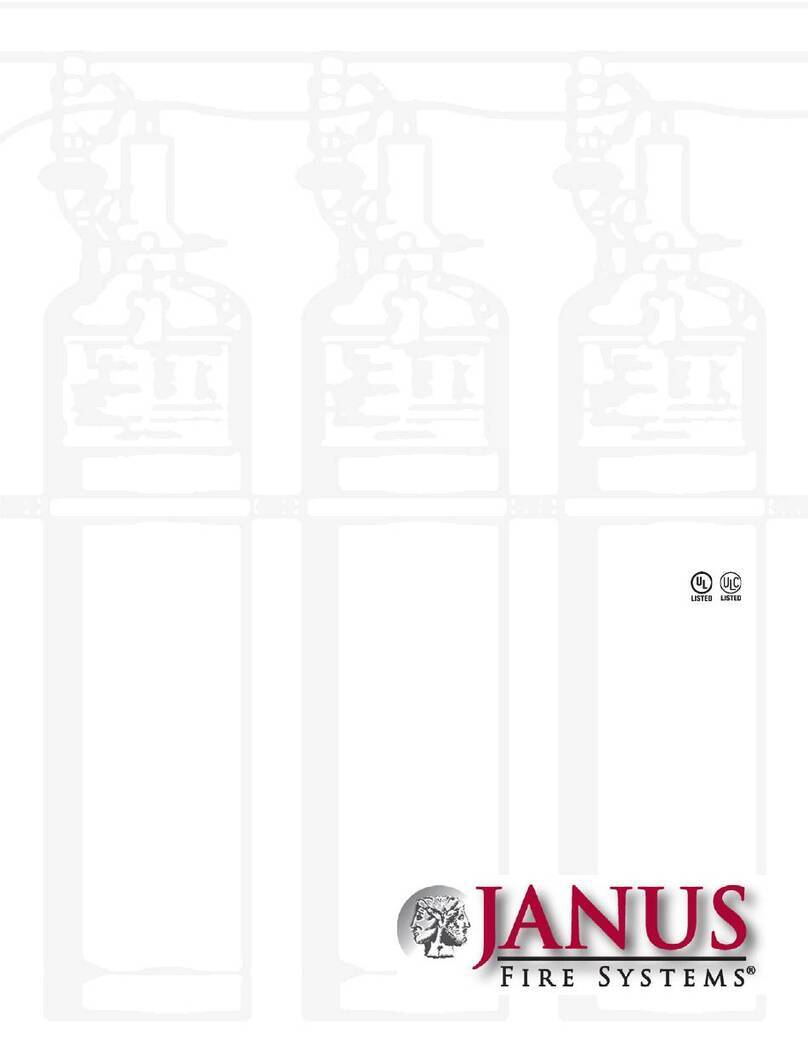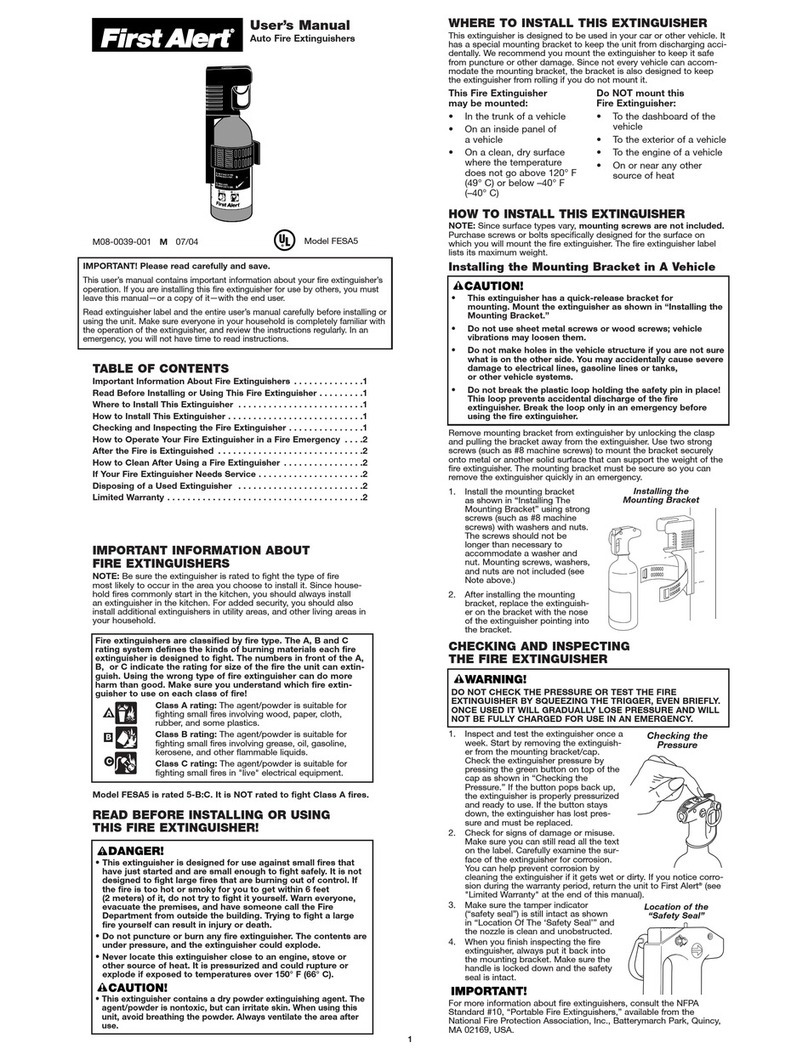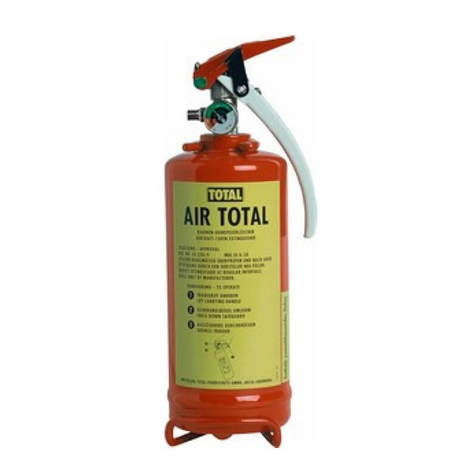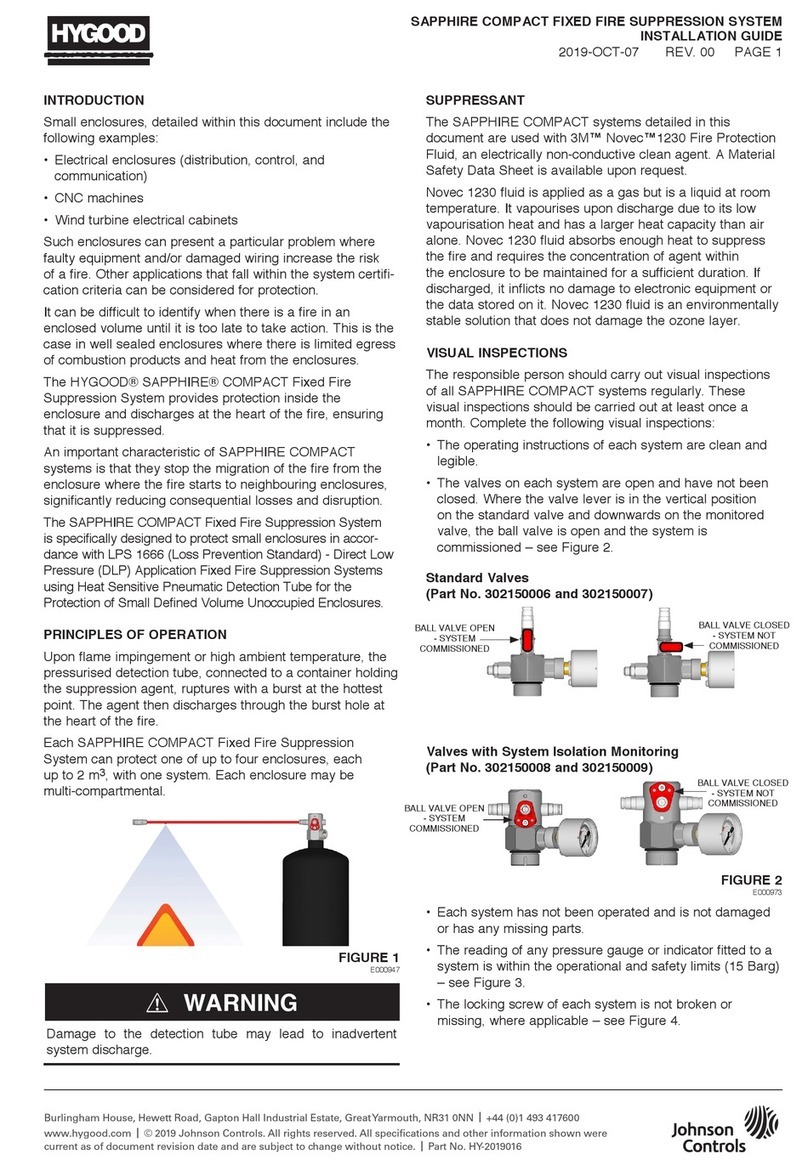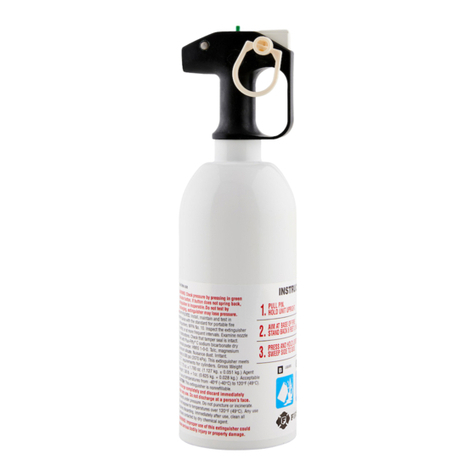Johnson Controls SENTRY CD05-1 Installation instructions

CARBON DIOXIDE
HAND PORTABLE
FIRE EXTINGUISHER
OPERATION, INSPECTION, SERVICE AND MAINTENANCE, AND RECHARGE MANUAL
One Stanton Street |Marinette, WI 54143-2542, USA |+1-715-735-7411 |www.ansul.com
© 2018 Johnson Controls. All rights reserved. All specifications and other information shown were
current as of document revision date and are subject to change without notice. |Part No. 429425-05
004990


SENTRY Carbon Dioxide Hand Portable Fire Extinguishers
Operation, Inspection, Service and Maintenance,
and Recharge Manual (Part No. 429425)
2018-OCT-11 REV. 05
FOREWORD
This manual is intended for use with SENTRY Carbon Dioxide
Hand Portable Fire Extinguishers – Models:
CD05-1 CD10-1 CD15-1 CD20-1
CD05A-1 CD10A-1 CD15A-1 CD20A-1
CD10-2 CD15-2 CD20-2
Those who may operate, recharge, inspect, or maintain these
fire extinguishers should read this entire manual. Specific
sections will be of particular interest depending upon one’s
responsibilities.
Fire extinguishers are mechanical devices. They require
periodic care. If the extinguishers are not installed properly, are
abused in service or are not properly maintained, they may not
perform reliably.
These extinguishers are pressure vessels that must be treated
with respect and handled with care.
Only genuine SENTRY replacement components shall be
installed on SENTRY products. Only Authorized SENTRY
Distributors shall be allowed to service and maintain SENTRY
products.
This manual is limited to uses herein described. For other appli-
cations, contact your local Authorized SENTRY Distributor or
Johnson Controls – Technical Services Department, Marinette,
Wisconsin 54143-2542, USA.
Note: The converted metric values in this manual are provided
for dimensional reference only and do not reflect an actual
measurement.
Part Number: 429425
Date: 2018-AUG-07
SENTRY and the product names listed in this material are marks and/or registered
marks. Unauthorized use is strictly prohibited.

SENTRY Carbon Dioxide Hand Portable Fire Extinguishers
Operation, Inspection, Service and Maintenance,
and Recharge Manual (Part No. 429425)
REV. 05 2018-OCT-11
EXPLANATION OF SAFETY ALERTS
p
!DANGER
Indicates a hazardous situation in which a person will
experience serious personal injury or death if the situation
is not avoided.
!WARNING
Indicates a hazardous situation in which a person could
experience serious personal injury or death if the situation
is not avoided.
!CAUTION
Indicates a hazardous situation in which a person could
experience minor or moderate personal injury if the
situation is not avoided.
CAUTION
Addresses practices not related to personal injury, such as
a system part malfunctioning, property damage, or system
failure.
NOTICE
Addresses general practices or observations
related to system function that are not related
to personal injury.

SENTRY Carbon Dioxide Hand Portable Fire Extinguishers
Operation, Inspection, Service and Maintenance,
and Recharge Manual (Part No. 429425)
TABLE OF CONTENTS
2018-OCT-11 REV. 05 PAGE TOC-1
SECTION PAGE
Introduction 1–2
Operation 3
Inspection 5
Maintenance 7–8
Recharge 9–10
Service and Repair 11–12

SENTRY Carbon Dioxide Hand Portable Fire Extinguishers
Operation, Inspection, Service and Maintenance,
and Recharge Manual (Part No. 429425)
PAGE TOC-2 REV. 05 2018-OCT-11
TABLE OF CONTENTS
NOTES:

SENTRY Carbon Dioxide Hand Portable Fire Extinguishers
Operation, Inspection, Service and Maintenance,
and Recharge Manual (Part No. 429425)
INTRODUCTION
2018-OCT-11 REV. 05 PAGE 1
INTRODUCTION
When utilized, the Occupational Safety and Health Act
(OSHA) rules require that ‘‘the employer shall be responsible
for the inspection, maintenance, and testing of all portable
extinguishers in the work place.’’ Details are provided in the
Code of Federal Regulations 29 CFR 1910.157(e) and in
Appendixes A and B to Subpart L, referencing the provisions
of NFPA 10 as guidelines. The latest edition of NFPA 10
‘‘Standard for Portable Fire Extinguishers’’ is available from
the National Fire Protection Association, visit www.nfpa.org.
The Compressed Gas Association Inc. CGA C-6 ‘‘Standards
For Visual Inspection of Steel Compressed Gas Cylinders’’
and CGA C-6.1 ‘‘Standards For Visual Inspection of High
Pressure Aluminum Compressed Gas Cylinders’’ provides
information on determining unacceptable dents and corrosion.
It is available from the Compressed Gas Association, Inc., visit
www.cganet.com.
RESPONSIBILITY
The owner or occupant of a property in which fire extin-
guishers are located has an obligation for the care and use of
these extinguishers at all times. By doing so, he/she is contrib-
uting to the protection of life and property. The nameplates
and instruction manual should be read and thoroughly under-
stood by all personnel who may be expected to operate,
recharge, inspect or maintain the extinguishers.
!WARNING
When performing recharge, use only those materials specified
on the extinguisher nameplate. The use of other recharging
materials may reduce the efficiency, cause malfunction, or
result in rupture of the extinguisher that could cause injury to
the operator.
INSPECTION
Inspection is a ‘‘quick-check’’ to give reasonable assurance
an extinguisher is fully charged and operable. It includes
checking that an extinguisher is in its designated location, that
it has not been actuated or tampered with, and that there is
no obvious physical damage or condition to prevent operation.
The value of an inspection lies in the frequency, regularity,
and thoroughness with which it is conducted. The frequency
will vary from hourly to monthly, based on the needs of the
situation.
MAINTENANCE
Extinguishers shall be maintained at regular intervals, not
more than one year apart, or when specifically indicated by
an inspection. Maintenance is a ‘‘thorough check’’ to give
maximum assurance the extinguisher will operate effec-
tively and safely. It includes a thorough examination and any
necessary repair, recharge, or replacement. It will normally
reveal if there is a need for hydrostatic testing.
RECHARGE
All extinguishers shall be recharged immediately after use, or
when indicated by an inspection or maintenance examination.
Recharge is the replacement or replenishment of the
suppressing agent.
HYDROTEST
Extinguishers shall be hydrostatically tested at regular
intervals as required in the latest edition of NFPA 10,
‘‘Standard for Portable Fire Extinguishers,’’ or more frequently
when inspection or maintenance dictates a specific need.
Such tests are usually required on extinguisher shells and
some hose assemblies. For further details, see SENTRY/
CLEANGUARD Fire Extinguisher Hydrostatic Test Instructions
(Form No. T-2017001).
!WARNING
For safety: If, at any time, an extinguisher shows evidence of
corrosion or mechanical injury, it shall be subjected to a hydro-
static pressure test or replaced.
!WARNING
Do not use air or gas for pressure testing. Failure to comply
could result in severe personal injury or death if the shell
ruptures.
RECORD KEEPING
Each extinguisher shall have a tag or label securely attached
that indicates the month and year the maintenance was
performed and shall identify the person performing the service.
The same record tag or label shall indicate if recharging was
also performed. The tag shall not be placed on the front of
the extinguisher where it could obscure operating instructions.
At least monthly, the date the inspection was performed and
the initials of the person performing the inspection shall be
recorded.
In addition to the required tag or label, a permanent file
record should be kept for each extinguisher. The file record
should also include the maintenance date and the name of
the person or agency performing the maintenance; the date
when last recharged and the name of the person performing
the hydrostatic test; and a description of dents remaining after
passing a hydrostatic test.
Parts of the above taken from NFPA Pamphlet 10.

SENTRY Carbon Dioxide Hand Portable Fire Extinguishers
Operation, Inspection, Service and Maintenance,
and Recharge Manual (Part No. 429425)
INTRODUCTION
PAGE 2 REV. 05 2018-OCT-11
REFERENCES
REFERENCES IN THIS MANUAL: AVAILABLE FROM:
NFPA-10 “STANDARD FOR NFPA
PORTABLE FIRE 1 Batterymarch Park
EXTINGUISHERS” Quincy, MA 02169-7471
CGA C-1 “METHODS FOR Compressed Gas
HYDROSTATIC Association
TESTING OF 14501 George
COMPRESSED Carter Way, Suite 103
GAS CYLINDERS” Chantilly, VA 20151-1788
CGA C-6 “STANDARD FOR
VISUAL INSPECTION
OF STEEL
COMPRESSED
GAS CYLINDERS”

SENTRY Carbon Dioxide Hand Portable Fire Extinguishers
Operation, Inspection, Service and Maintenance,
and Recharge Manual (Part No. 429425)
2018-OCT-11 REV. 05 PAGE 3
OPERATION
OPERATION
!WARNING
Carbon dioxide extinguishers contain a suppressing agent
that will not support life when used in sufficient concentration
to suppress a fire. The use of this type of extinguisher in an
unventilated space can dilute the oxygen supply. Prolonged
occupancy of such spaces can result in loss of consciousness
and possible death due to oxygen deficiency.
1. Remove extinguisher from its hanger.
2. Use handle to carry extinguisher to fire. Walk at a rapid
pace. DO NOT RUN.
3. Proceed to upwind side of fire. Stay well clear of flames.
From this position, air currents help carry agent into fire,
assure maximum visibility, provide protection from heat,
and lessen exposure to possible harmful vapors.
4. Start back from fire a distance recommended on
extinguisher nameplate. Holding extinguisher by handle,
grasp ring pin and pull straight out, breaking visual seal.
5. 5 lb Extinguisher: Position tube/horn assembly and
squeeze handle lever to discharge agent.
10, 15, or 20 lb Extinguishers: Hold the nozzle with one
hand and squeeze handle lever to discharge agent.
NOTICE
For additional information on proper use
and applications of SENTRY Carbon
Dioxide Extinguishers, Johnson Controls
maintains a comprehensive library of
training aids and offers hands-on fire
fighting training at our fire school. Contact
Johnson Controls, One Stanton Street,
Marinette, WI 54143-2542, or your
Authorized SENTRY Distributor.

SENTRY Carbon Dioxide Hand Portable Fire Extinguishers
Operation, Inspection, Service and Maintenance,
and Recharge Manual (Part No. 429425)
PAGE 4 REV. 05 2018-OCT-11
OPERATION
NOTES:

SENTRY Carbon Dioxide Hand Portable Fire Extinguishers
Operation, Inspection, Service and Maintenance,
and Recharge Manual (Part No. 429425)
2018-OCT-11 REV. 05 PAGE 5
INSPECTION
INSPECTION
Inspection provides reasonable assurance the extinguisher is
charged and operable. Where an inspection reveals tampering
has occurred or the extinguisher is damaged, impaired,
leaking, or has obvious corrosion, the complete maintenance
as described on Pages 7-8 should be followed.
NOTICE
Become familiar with the Service and Repair
section prior to performing inspection.
1. Make certain extinguisher is in its designated place, is
clearly visible and is accessible for immediate use. Any
obstructions that obscure it, or that would otherwise
impair its being readily accessible, should be removed.
2. Check visual seal on valve lever. The absence of a seal
or a broken seal may indicate either unreported use or
tampering. In either case, a complete maintenance check
is required.
3. Extinguisher shall be weighed or hefted every month and
recharged if weight loss is in excess of 1 lb (0.45 kg) or if
overweight. Total charged weight is stamped on the valve
body and includes hose and horn assembly.
4. Remove extinguisher from its wall hanger or bracket.
Examine extinguisher for evidence of physical damage,
corrosion or other impairments.
5. Check nameplate for readability.
6. Examine horn or horn/hose assembly for cuts, severe
weather checking, abrasion, cracks or deformed exterior.
7. Check hose couplings for tightness, corrosion or cracks.
A loose connection on the coupling could contribute
to a significant change in discharge characteristics. A
corroded or cracked coupling could separate under pres-
sure.
8. Check horn for obstruction. Insects are common causes
of obstructions particularly in warmer climates.
9. Make sure wall hanger or bracket is properly fastened to
hold total extinguisher weight.
10. Return extinguisher to its designated location.
11. Personnel making inspections are usually required to
keep records by way of marking a tag attached or affixed
to the extinguisher and/or in a permanent file. Your
precise guide to record keeping requirements should be
the applicable company, local, state or federal authority
having jurisdiction.
12. Record the date of recharge on the tag (Part No. 2364)
affixed or attached to the extinguisher and in your
permanent file record in accordance with company, local,
state or federal codes, regulations or standards.

SENTRY Carbon Dioxide Hand Portable Fire Extinguishers
Operation, Inspection, Service and Maintenance,
and Recharge Manual (Part No. 429425)
PAGE 6 REV. 05 2018-OCT-11
INSPECTION
NOTES:

SENTRY Carbon Dioxide Hand Portable Fire Extinguishers
Operation, Inspection, Service and Maintenance,
and Recharge Manual (Part No. 429425)
2018-OCT-11 REV. 05 PAGE 7
MAINTENANCE
MAINTENANCE
If a questionable condition exists, refer to Service and Repair
section, pages 11-12.
NOTICE
Become familiar with the Service and Repair
section prior to performing maintenance.
To help provide maximum assurance the extinguisher
will operate effectively and safely, maintenance must be
conducted annually, or sooner when specifically indicated by
an inspection:
!CAUTION
Always be alert for any indications of damage or inoperative-
ness in the extinguisher. No manual can anticipate everything
that could happen to an extinguisher. In the event something
not covered in the manual is found, ascertain whether any
potential for damage or effect on operation of the extinguisher
or safety exists and repair or replace, as necessary.
1. Make certain extinguisher is in its designated place,
readily accessible and immediately available in the event
of fire.
2. Remove extinguisher from its wall hanger. Check to see
that hanger is firmly fastened to mounting surface.
NOTICE
Extinguishers taken out of service
for maintenance or recharge shall be
replaced by spare extinguishers of the
same type and at least equal rating.
3. Clean extinguisher to remove dirt, grease and foreign
material.
4. Check cylinder for date of manufacture. If five years or
more have passed since most recent date stamp, cylinder
must be hydrotested before returning to service. Date
will appear as month (i.e., 3 = March, 8 = August, etc.)
followed by the inspector’s stamp and then year (last two
digits). See Figure 1.
FIGURE 1
006531
5. Weigh the unit.
6. Inspect tank for corrosion, abrasion, or dents in accor-
dance with CGA Visual Inspection Standards, Pamphlets
C-6 and C-6.1.
7. Visually inspect extinguisher for missing, substituted
or broken parts. Only SENTRY replacement parts are
allowed.
8. 10 lb, 15 lb, or 20 lb Extinguishers Only: Remove and
inspect horn/hose assembly as follows:
a. Using open end wrench, disengage hose from valve.
b. Check hose assembly for any blockage.
c. Perform conductivity test on hose by attaching one
lead of an ohmmeter to one hose coupling and other
lead to opposite hose coupling. With meter set in ohms
range, reading should show approximately 0 ohms,
indicating a complete circuit exists through hose. See
Figure 2. If meter indicates an open circuit, hose must
be replaced.
FIGURE 2
002814
d. Do not install hose to valve at this time.

SENTRY Carbon Dioxide Hand Portable Fire Extinguishers
Operation, Inspection, Service and Maintenance,
and Recharge Manual (Part No. 429425)
PAGE 8 REV. 05 2018-OCT-11
MAINTENANCE
MAINTENANCE (Continued)
9. 5 lb Extinguisher Only: Remove and inspect horn
assembly as follows:
a. Using open end wrench, rotate hex swivel in counter-
clockwise direction to remove from valve assembly.
See Figure 3.
FIGURE 3
004996
b. Check tube for any blockage.
c. Reassemble hex swivel to valve body by threading
clockwise onto hole in valve body and wrench tighten.
10. 10 lb, 15 lb, or 20 lb Extinguishers Only: Inspect
defusing holes on valve to make sure they are not
blocked. See Figure 4.
FIGURE 4
004995
11. 5 lb Extinguisher Only: Assure nut attached to hex
swivel rotates freely but not loosely.
12. Check siphon tube by shaking entire extinguisher. A
metallic rattling noise indicates separation of siphon tube
from valve.
13. Follow instructions in Recharge section to empty and
recharge extinguisher.
14. Return extinguisher to its designated location.
15. Personnel making maintenance checks are usually
required to keep records by way of marking a tag
attached or affixed to the extinguisher and/or in a
permanent file. Your precise guide to record keeping
requirements should be the applicable company, local,
state or federal authority having jurisdiction.
16. Record the date of recharge on the tag (Part No. 2364)
affixed or attached to the extinguisher and in your
permanent file record in accordance with company, local,
state or federal codes, regulations or standards.

SENTRY Carbon Dioxide Hand Portable Fire Extinguishers
Operation, Inspection, Service and Maintenance,
and Recharge Manual (Part No. 429425)
2018-OCT-11 REV. 05 PAGE 9
RECHARGE
RECHARGE
Before recharging any extinguisher, visually examine the
unit for any physical damage or impairment which may
further dictate the need for maintenance.
NOTICE
Extinguishers taken out of service for mainte-
nance or recharge shall be replaced by spare
extinguishers of the same type and at least
an equal rating.
1. Discharge all remaining CO2from extinguisher.
!WARNING
When discharging carbon dioxide for recharge purposes,
it should always be discharged to an outside atmosphere.
The discharging of this type of extinguisher in an unven-
tilated space can dilute the oxygen supply. Prolonged
occupancy of such spaces can result in loss of conscious-
ness and possible death due to oxygen deficiency.
Always wear gloves and goggles or a face shield as CO2
gas could cause freezing if sprayed on bare skin or in the
eyes.
NOTICE
If charging multiple extinguishers, keep the
components for each extinguisher separate.
Valve assemblies and shells are not indexed
and nameplates may not line up properly if
valve assemblies are transposed.
2. Check cylinder shoulder for date of manufacture. If five
years or more have passed since most recent date
stamp, cylinder must be hydrotested before returning to
service. Date will appear as the month (i.e., 3 = March,
8 = August, etc.) followed by the inspector’s stamp and
then the year (last two digits).
3. Remove horn/hose assembly (10-15-20 lb models) or
horn (5 lb model) as follows:
a. Horn/Hose assembly – Using open end wrench,
disengage hose from valve assembly. See Figure 5.
FIGURE 5
004993
b. Horn – Using open end wrench, disengage hex swivel
from valve assembly. See Figure 6.
FIGURE 6
004996
c. Inspect tank for corrision, abrasion, or dents in
accordance with CGA Visual Inspection Standards,
Pamphlets C-6 and C-6.1.
4. Attach proper recharge adaptor to valve.
5. Place extinguisher on scale. Attach spring clamp to hold
extinguisher valve in open position.
6. Connect CO2supply line to recharge adaptor.

SENTRY Carbon Dioxide Hand Portable Fire Extinguishers
Operation, Inspection, Service and Maintenance,
and Recharge Manual (Part No. 429425)
PAGE 10 REV. 05 2018-OCT-11
RECHARGE
RECHARGE (Continued)
7. Open fill line valve and fill cylinder to correct total weight*
as stamped on valve assembly. DO NOT OVERFILL.
!WARNING
When performing recharge, use only the proper materials.
The use of other recharging materials may reduce the
efficiency, cause malfunction or result in rupture of the
extinguisher that could cause injury to the operator.
NOTICE
Carbon dioxide (CO2) used to fill the
extinguisher must conform to item
description as specified in UL Standard
154, as follows: ‘‘A commercial grade of
carbon dioxide, free of water and other
contaminants that might cause corrosion
or interfere with the discharge of the
extinguisher. The vapor phase shall be
not less than 99.5 percent carbon dioxide
with no detectable off-taste or odor. The
water content shall be not more than
60 parts per million (ppm) by weight at
–52 °F (–46.6 °C) dew point. Oil content
shall be not more than 10 parts per
million (ppm) by weight.’’
*Total weight includes hose and horn assembly
8. Release spring clamp from operating lever when scale
indicates correct amount of CO2has been introduced
into cylinder. Close CO2supply line valve and vent CO2
supply line to outside atmosphere.
9. Install ring pin and visual seal.
10. Remove CO2supply line from charging adaptor. Remove
adaptor from valve.
11. Perform leak check on all joints or possible sources of
leakage. (Leak check may consist of a bubble test using
a soapy water solution or any of several commercially
available preparations such as ’’Leak-Tek’’.) If no bubbles
appear, wipe extinguisher clean and air dry. If leaks
(bubbles) appear, refer to Service and Repair section.
12. Reinstall horn or horn/hose assembly.
13. Check weight of recharged extinguisher against weight
stamped on extinguisher valve body. See Figure 7.
FIGURE 7
004994
14. Return extinguisher to its designated location.
15. Personnel performing recharge are usually required to
keep records by way of marking a tag attached or affixed
to the extinguisher and/or in a permanent file. Your
precise guide to record keeping requirements should be
the applicable company, local, state or federal authority
having jurisdiction.
16. Record the date of recharge on the tag (Part No. 2364)
affixed or attached to the extinguisher and in your
permanent file record in accordance with company, local,
state or federal codes, regulations or standards.

SENTRY Carbon Dioxide Hand Portable Fire Extinguishers
Operation, Inspection, Service and Maintenance,
and Recharge Manual (Part No. 429425)
2018-OCT-11 REV. 05 PAGE 11
SERVICE AND REPAIR
SERVICE AND REPAIR
The best assurance against fire extinguisher malfunction is
proper operation, recharge, inspection and maintenance. To
remedy any disorder detected through periodic inspection or
maintenance examinations, the table on page 12 lists some of
the possible irregularities that may develop and gives sugges-
tions for corrective action. For further information, contact
Johnson Controls.
!WARNING
Contents under high pressure. Before removing or disassem-
bling valve, make sure extinguisher is completely discharged.
Failure to comply could result in personal injury or property
damage due to violent movement of loosened components.
!WARNING
When discharging carbon dioxide for service and repair
purposes, it should always be discharged to an outside atmo-
sphere. The discharging of this type of extinguisher in an
unventilated space can dilute the oxygen supply. Prolonged
occupancy of such spaces can result in loss of consciousness
and possible death due to oxygen deficiency.

SENTRY Carbon Dioxide Hand Portable Fire Extinguishers
Operation, Inspection, Service and Maintenance,
and Recharge Manual (Part No. 429425)
PAGE 12 REV. 05 2018-OCT-11
SERVICE AND REPAIR
SERVICE AND REPAIR (Continued)
COMPONENT DISORDER CORRECTIVE ACTION
Cylinder Dents or abrasions* Hydrotest (See Form No. T-2017001, Hydrostatic Test
Instructions) or discard cylinder.
Rust spots, pits, corrosion* Clean affected area. Replace if there is any corrosion
penetration.
Threads nicked, cross- Clean threads with a stiff bristle brush. If damaged or
threaded, corroded or worn worn, discard cylinder.
Valve Leak at safety nut Remove nut, disc and washer. Clean out receptacle. Replace
with new components. Torque to 17 ft-lb to 20 ft-lb (23.2 N•m to
27.1 N•m).
Leak through valve outlet Discharge. Disassemble valve. Replace plunger stem.
Leak at plunger stem Discharge. Disassemble valve. Replace plunger stem.
(Under operating lever)
Leak at hose joint Disassemble and examine internal and external threads.
Replace hose if damaged.
Leak at hex swivel/valve joint Disassemble. Clean seating surface. Reassemble.
(5 lb extinguisher only) Assure tube rotates freely but not loosely.
Leak at cylinder/valve joint Examine for cracks around perimeter of cylinder neck. Discard
if cracks are found. If leaking at thread joint, remove valve from
cylinder. Clean threads with stiff brush. On aluminum shell only,
replace O-ring. On steel shell only, lightly lubricate valve thread
with DOW 111 or equal and reinstall valve. Torque steel shell
to 50 ft lb (68 Nm). Tighten aluminum shell hand tight.
Sticky valve Disassemble valve. Examine valve stem and push lever.
Replace if damaged. Replace stem O-ring and adequately
lubricate.
Nameplate Unreadable Use a mild detergent to clean plate. If readability cannot be
improved, replace nameplate.**
Loose Inspect under plate. If corroded, see ‘‘Cylinder-Rust spots, pits
and corrosion’’ and reaffix nameplate using a good grade of
heatless adhesive.
Missing Replace with new nameplate.**
Hose Cut, cracked or abraded Replace hose assembly.
Corroded or cracked coupling Replace hose assembly.
Internal blockage Clear by flexing or blowing air or nitrogen through hose at 50
psi (3.5 bar) or less. Replace if blockage cannot be removed.
CAUTION
Do not leave open end of hose unattended unless
adequately restrained to prevent whipping.
Horn Cracked Replace horn.
* Refer to Compressed Gas Association (CGA) pamphlets C-6 and C-6.1.
** Replacement maintenance nameplates from Johnson Controls will not have a UL manifest.


This manual suits for next models
10
Table of contents
Other Johnson Controls Fire Extinguisher manuals
